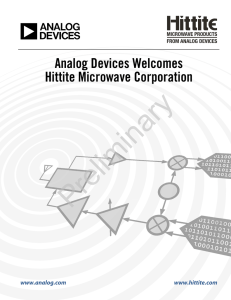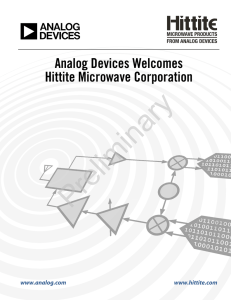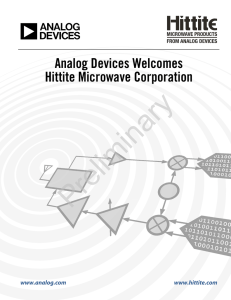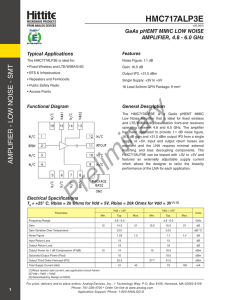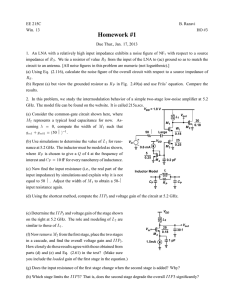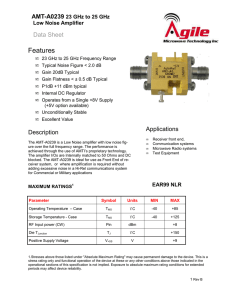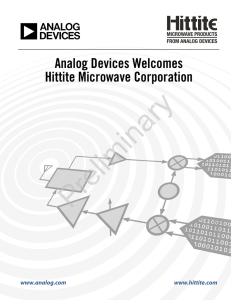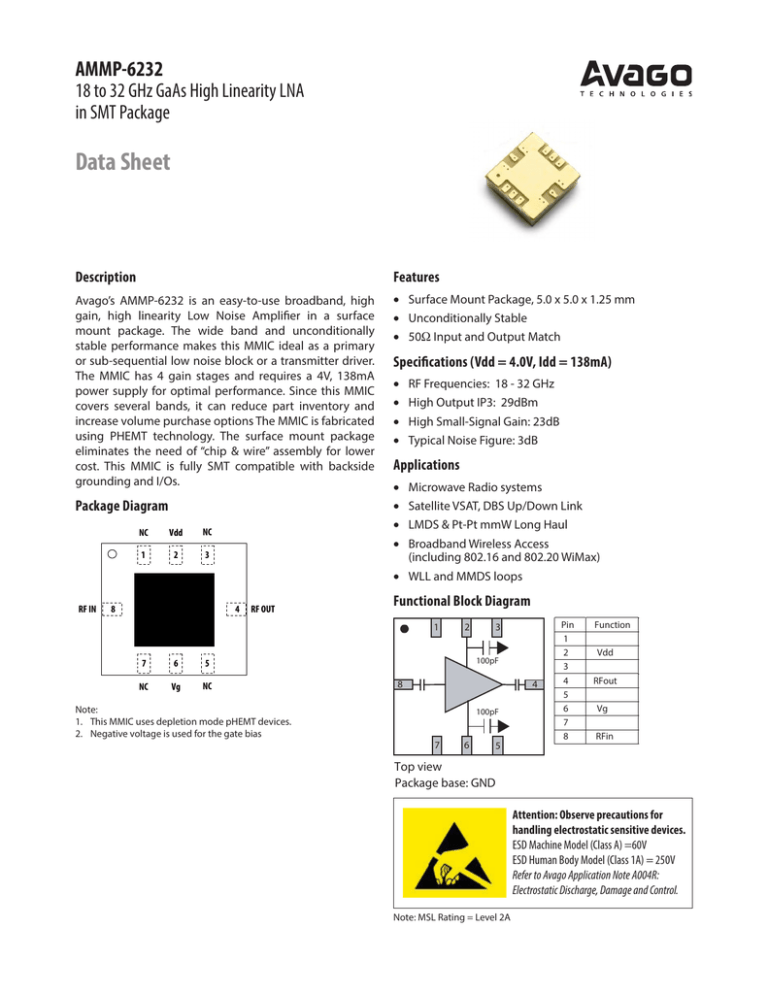
AMMP-6232
18 to 32 GHz GaAs High Linearity LNA
in SMT Package
Data Sheet
Description
Features
Avago’s AMMP-6232 is an easy-to-use broadband, high
gain, high linearity Low Noise Amplifier in a surface
mount package. The wide band and unconditionally
stable performance makes this MMIC ideal as a primary
or sub-sequential low noise block or a transmitter driver.
The MMIC has 4 gain stages and requires a 4V, 138mA
power supply for optimal performance. Since this MMIC
covers several bands, it can reduce part inventory and
increase volume purchase options The MMIC is fabricated
using PHEMT technology. The surface mount package
eliminates the need of “chip & wire” assembly for lower
cost. This MMIC is fully SMT compatible with backside
grounding and I/Os.
• Surface Mount Package, 5.0 x 5.0 x 1.25 mm
• Unconditionally Stable
•50W Input and Output Match
Package Diagram
RF IN
NC
Vdd
NC
1
2
3
8
4
RF OUT
Specifications (Vdd = 4.0V, Idd = 138mA)
•
•
•
•
RF Frequencies: 18 - 32 GHz
High Output IP3: 29dBm
High Small-Signal Gain: 23dB
Typical Noise Figure: 3dB
Applications
•
•
•
•
Microwave Radio systems
Satellite VSAT, DBS Up/Down Link
LMDS & Pt-Pt mmW Long Haul
Broadband Wireless Access
(including 802.16 and 802.20 WiMax)
• WLL and MMDS loops
Functional Block Diagram
1
7
6
5
NC
Vg
NC
Note:
1. This MMIC uses depletion mode pHEMT devices.
2. Negative voltage is used for the gate bias
2
3
100pF
4
8
100pF
7
6
5
Pin
1
2
3
4
5
6
7
8
Function
Vdd
RFout
Vg
RFin
Top view
Package base: GND
Attention: Observe precautions for
handling electrostatic sensitive devices.
ESD Machine Model (Class A) =60V
ESD Human Body Model (Class 1A) = 250V
Refer to Avago Application Note A004R:
Electrostatic Discharge, Damage and Control.
Note: MSL Rating = Level 2A
Electrical Specifications
1. Small/Large -signal data measured in a fully de-embedded test fixture form TA = 25°C.
2. Pre-assembly into package performance verified 100% on-wafer per AMMC-6220 published specifications.
3. This final package part performance is verified by a functional test correlated to actual performance at one or more
frequencies.
4. Specifications are derived from measurements in a 50 Ω test environment. Aspects of the amplifier performance may
be improved over a more narrow bandwidth by application of additional conjugate, linearity, or low noise (Гopt)
matching.
5. All tested parameters guaranteed with measurement accuracy +/-1.5 dB for gain and +/-0.4dB for NF
Table 1. RF Electrical Characteristics
TA=25°C, Vdd=4.0V, Idd=135mA, Zo=50 Ω
Parameter
Min
Typ.
Small Signal Gain, Gain
19
23
Max
4.5
Unit
Comment
dB
Test Frequency = 20, 26, 29 GHz
dB
Test Frequency = 20, 26, 29 GHz
Noise Figure into 50 Ω, NF
3
Output Power at 1 dB Gain Compression, P-1dB
18
dBm
Output Power at 3 dB Gain Compression, Psat
20
dBm
Output Third Order Intercept Point, OIP3
29
dBm
Isolation, Iso
-45
dB
Input Return Loss, RLin
-10
dB
Output Return Loss, RLout
-10
dB
Table 2. Recommended Operating Range
1. Ambient operational temperature TA = 25°C unless otherwise noted.
2. Channel-to-backside Thermal Resistance (Tchannel (Tc) = 34°C) as measured using infrared microscopy. Thermal
Resistance at backside temperature (Tb) = 25°C calculated from measured data.
Description
Min.
Drain Supply Current, Idd
Drain Supply Voltage, Vd
3
Gate Bias Current, Ig
Gate Bias Voltage, Vg
2
Typical
Max.
Unit
Comments
135
150
mA
Vd = 4.5 V, Under any RF power drive and temperature
4
5
V
0.1
-1.1
-0.95
mA
-0.8
V
Table 3. Thermal Properties
Parameter
Test Conditions
Value
Thermal Resistance, qjc
Channel-to-backside Thermal Resistance Tchannel(Tc)=34°C
Thermal Resistance at backside temperature Tb=25°C
qch-b = 35.1 °C/W
Absolute Minimum and Maximum Ratings
Table 4. Minimum and Maximum Ratings
Description
Pin
Max.
Unit
Drain to Ground Supply Voltage
Vdd
Min.
5.5
V
Gate-Drain Voltage
Vgd
-8
V
Drain Current
Idd
200
mA
Gate Bias Voltage
Vg
+0.8
V
Gate Bias Current
Ig
1
mA
RF CW Input Power
Pin
10
dBm
+150
°C
+150
°C
+260
°C
Channel Temperature
Storage Temperature
Maximum Assembly Temperature
-65
Notes:
1. Operation in excess of any one of these conditions may result in permanent damage to this device.
3
Comments
20 second maximum
AMMP-6232 Typical Performance [1, 2]
40
5
30
4
Noise Figure (dB)
S21 (dB)
(TA = 25°C, Vdd=4V, Idd=138mA, Zin = Zout = 50 W unless noted)
20
10
0
3
2
1
0
15
20
25
30
35
18
20
22
Frequency (GHz)
28
30
32
Figure 2. Noise Figure
0
20
-5
15
-1 0
OP1dB (dBm)
S11 (dB)
26
Frequency (GHz)
Figure 1. Small-signal Gain
-1 5
-2 0
-2 5
15
20
25
30
10
5
0
35
18
Frequency (GHz)
Figure 3. Input Return Loss
20
22
24
26
Frequency (GHz)
28
30
32
28
30
32
Figure 4. Output P-1dB
0
30
-5
25
-10
20
OIP3 (dBm)
S22 (dB)
24
-15
-20
15
10
5
-25
15
20
25
30
35
18
20
Frequency (GHz)
Figure 5. Output Return Loss
22
24
26
Frequency (GHz)
Figure 6. Output IP3
Note:
1. S-parameters are measured on R&D Eval Board as shown in Figure 20. Effects of connectors and board traces are included in results.
2. Noise Figure is measured on R&D Eval Board as shown in Figure 20, and with a 3dB pad at the input. Board and Connector losses are already deembeded from the data.
4
AMMP-6232 Typical Performance (cont.)
-2 0
200
-3 0
170
-4 0
Idd (mA)
S12 (dB)
(TA = 25°C, Vdd=4V, Idd=138mA, Zin = Zout = 50 W unless noted)
-5 0
140
110
-6 0
80
-7 0
15
20
25
30
Frequency (GHz)
50
35
3
5
5
4
Noise Figure (dB)
30
20
4V
5V
3V
10
0
15
20
25
30
3
3V
4V
5V
2
1
0
18
35
20
22
24
26
28
30
32
Frequency (GHz)
Frequency (GHz)
Figure 9. Gain over Vdd
Figure 10. Noise Figure over Vdd
0
0
-5
-5
-1 0
-1 5
S22 (dB)
-1 0
S11 (dB)
4 .5
Figure 8. Total Current
40
4V
3V
-2 0
15
-1 5
4V
-2 0
5V
-2 5
5V
-2 5
3V
-3 0
20
25
Frequency (GHz)
Figure 11. Input Return Loss Over Vdd
5
4
Vdd (V)
Figure 7. Isolation
S21 (dB)
3 .5
30
35
15
20
25
Frequency (GHz)
Figure 12. Output Return Loss Over Vdd
30
35
AMMP-6232 Typical Performance (cont.)
(TA = 25°C, Vdd=4V, Idd=138mA, Zin = Zout = 50 W unless noted)
25
35
30
25
OIP3 (dBm)
OP1dB (dBm)
20
15
3V
4V
10
5V
5
18
20
22
24
26
28
30
20
3V
15
4V
10
5V
5
32
18
20
22
Frequency (GHz)
Figure 13. Output P-1dB over Vdd
30
32
4
Noise Figure (dB)
S21 (dB)
28
5
30
20
25C
10
85C
-40C
0
15
20
25
30
3
2
-40C
25C
85C
1
0
18
35
20
22
24
26
28
30
32
Frequency (GHz)
Frequency (GHz)
Figure 15. Gain over Temp
Figure 16. Noise Figure over Temp
0
0
-5
-5
-10
-1 0
-1 5
S22 (dB)
S11 (dB)
26
Figure 14. Output IP3 Over Vdd
40
25 C
-4 0C
85 C
-2 0
-2 5
15
20
-15
25 C
85 C
-40C
-20
-25
-30
25
Frequency (GHz)
Figure 17. Input Return Loss Over Temp
6
24
Frequency (GHz)
30
35
15
20
25
Frequency (GHz)
Figure 18. Output Return Loss Over Temp
30
35
AMMP-6232 Application and Usage
Biasing and Operation
The AMMP-6232 is normally biased with a positive drain
supply connected to the VDD pin and a negative gate
bias through bypass capacitors as shown in Figure 19. The
recommended drain supply voltage is 4 V and the gate
bias is approximately -0.95V to get the corresponding
drain current of 138mA. It is important to have 0.1uF
bypass capacitors and the capacitor should be placed
as close to the component as possible. Aspects of the
amplifier performance may be improved over a narrower
bandwidth by application of additional conjugate,
linearity, or low noise (Topt) matching.
4V
Vdd
1
IN
0.1uF
2
3
100pF
8
4
OUT
After adjusting the gate bias to obtain 138mA at Vdd = 4V,
the AMMP-6232 can be safely biased at 3V or 5V (while
fixing the gate bias) as desired. At 4V, the performance is
an optimal compromise between power consumption,
gain and power/linearity. It is both applicable to be used
as a low noise block or driver. At 3V, the amplifier is ideal
as a front end low noise block where linearity is not highly
required. At 5V, the amplifier can provide 1 to 2dBm more
output power for LO or transmitter driver applications
where high output power and linearity are often required.
100pF
7
6
5
0.1uF
Vg
Top View
Package base: GND
~ -0.95V
Figure 19. Usage of the AMMP-6232
Refer the Absolute Maximum Ratings table for allowed DC
and thermal conditions.
Figure 20. Evaluation/Test Board (available to qualified customer request)
Vd1
Matching
Ne twork
In
Vg1
Figure 21. Simplified AMMP-6232 Schematic
7
Vd2
Matching
Network
Matching
Network
Vg2
Out
Typical Scattering Parameters
Please refer to <http://www.avagotech.com> for typical scattering parameters data.
Package Dimension, PCB Layout and Tape and Reel information
Please refer to Avago Technologies Application Note 5520, AMxP-xxxx production Assembly Process (Land Pattern A).
AMMP-6232 Part Number Ordering Information
Part Number
Devices Per
Container
Container
AMMP-6232-BLKG
10
Antistatic bag
AMMP-6232-TR1G
100
7” Reel
AMMP-6232-TR2G
500
7” Reel
For product information and a complete list of distributors, please go to our web site:
www.avagotech.com
Avago, Avago Technologies, and the A logo are trademarks of Avago Technologies in the United States and other countries.
Data subject to change. Copyright © 2005-2013 Avago Technologies. All rights reserved. Obsoletes AV01-0442EN
AV02-0491EN - July 8, 2013


